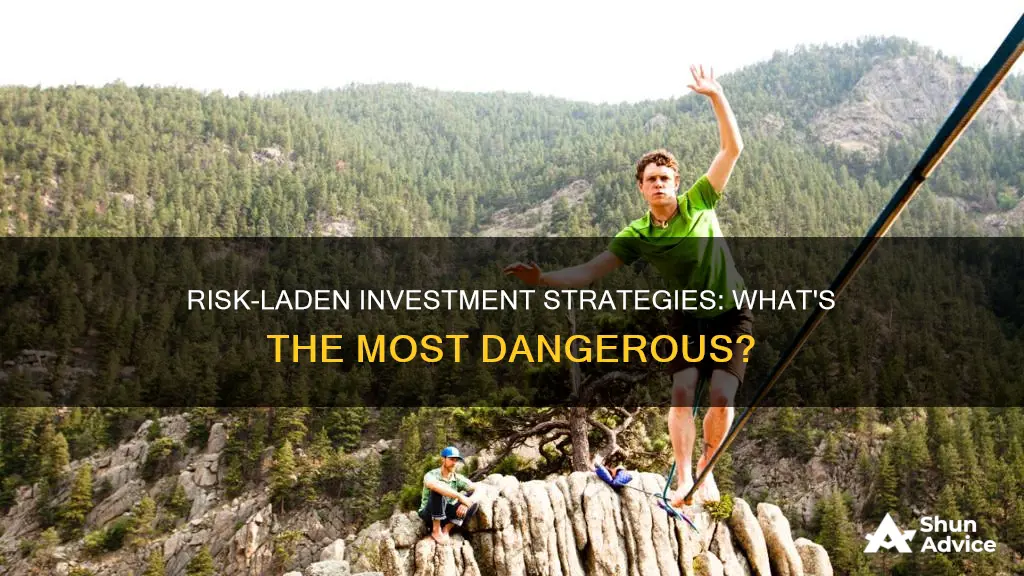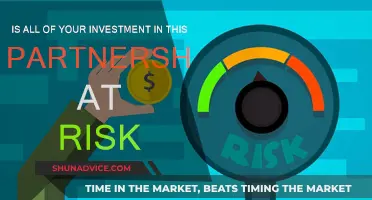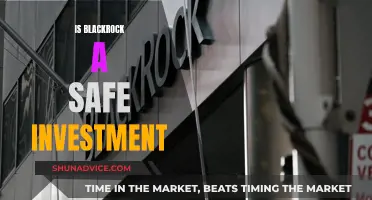
All investments carry some degree of risk, but certain strategies are riskier than others. High-risk, volatile investments may bring high rewards, but they can also bring high losses.
Some of the riskiest investments include cryptocurrency, individual stocks, private companies, peer-to-peer lending, hedge funds, and private equity funds. These investments offer the potential for high returns, but they also come with a lot of unknowns. For example, the price of Bitcoin soared to a record high of $69,000 in November 2021 but dropped to $42,822 by January 2022—a 37% loss in just two months.
Other high-risk investments include options, initial public offerings (IPOs), venture capital, foreign emerging markets, real estate investment trusts (REITs), high-yield bonds, and currency trading.
When deciding on an investment strategy, it's important to consider your risk tolerance and capacity. Your risk tolerance is how much risk you are willing to accept, while your risk capacity is the amount of financial risk you can take on given your current financial situation. It's also crucial to diversify your portfolio to offset potential losses.
| Characteristics | Values |
|---|---|
| Highest risk investments | Cryptocurrency, individual stocks, private companies, peer-to-peer lending, hedge funds, private equity funds, options, IPOs, venture capital, foreign emerging markets, REITs, high-yield bonds, currencies, penny stocks |
| Risk-reward relationship | Higher risk = higher possible return |
| Risk tolerance | How much risk an investor is willing to accept |
| Risk capacity | How much financial risk an investor is able to take on |
| Time horizon | The amount of time an investor has to keep their money invested |
| Bankroll | The amount of money an investor can afford to lose |
| Liquidity risk | How easy or hard it is to cash out of an investment |
| Concentration risk | The number of investments held |

Cryptocurrency
Volatility and Unpredictability
The price of crypto is extremely volatile, meaning it changes quickly and frequently, with high highs and low lows. For example, the price of Bitcoin dropped by 37% in just two months between November 2021 and January 2022. This volatility is due to the many factors that influence the price, such as regulatory uncertainties, market speculation, and news and events.
Regulatory Risk
Government regulations around crypto are constantly evolving and may differ based on your location. These regulations can impact how you use or access your crypto and cause further volatility and uncertainty. As crypto is still a relatively new asset class, it may take time for clear and consistent guidelines to be established.
Cybersecurity and Scams
Lack of Centralized Control
Cryptocurrencies are decentralized, meaning they are not controlled by a single government or central bank. While this provides users with unrestricted access to their coins, it also means that cryptocurrencies are not backed or insured by a central authority. This lack of centralized control and insurance means that there is no guarantee of protection for your investment.
Illiquidity
The highly volatile nature of cryptocurrency means that it can become illiquid at any time, making it difficult to convert your crypto into cash without incurring significant losses.
Market Manipulation
Crypto may be more susceptible to market manipulation than other securities due to its decentralized nature and the lack of regulatory oversight.
Suitability for High-Risk Investors
Given the high risks outlined above, investing in cryptocurrency is generally only suitable for investors with a high-risk tolerance and a long-time horizon. It is important to thoroughly educate yourself on the risks and only invest what you can afford to lose. Diversifying your portfolio with lower-risk investments can also help balance out the risks associated with crypto.
Loans and Equity Investments: What's the Difference?
You may want to see also

Individual stocks
There are several other reasons why individual stocks are a risky investment strategy:
- They require extensive research into factors like financial statements, management, competitors, markets, and industry trends. For individual investors, finding the time to do this research can be challenging.
- Individual investors are more prone to emotional biases, such as loss aversion and overconfidence, which can lead to buying high and selling low.
- Individual stocks are often more expensive than diversified funds, even when building a portfolio that rivals the diversification of a fund.
- Individual stocks do not benefit from the expertise and experience of fund managers, who have spent years analysing the markets and honing their ability to identify profitable investment opportunities.
- Individual stocks are more susceptible to adverse events affecting a single company, industry, or region, such as changes to regulation, seasonal performance, and general market fluctuations.
Despite the risks, some investors are drawn to individual stocks because of the potential for huge gains. However, it's important to remember that the odds of success from investing in single stocks are a lot lower than many people think. It's extremely unlikely that you'll find a stock that beats the market, and even professional investors with access to vast amounts of data struggle to outperform the overall market consistently.
Genesis Investment: Write to Secure Funding
You may want to see also

Private companies
Private equity investments carry a different degree of risk than other asset classes due to the nature of the underlying investments. Private equity money is often invested in new companies or startups with high growth potential. These investments often have high minimums, which can magnify gains but also losses.
Liquidity risk is a concern for investors in private equity. Investors are expected to invest their funds with the firm for several years on average, and some investments require even longer holding periods before any returns are experienced.
Market risk is also prevalent as many of the companies invested in are unproven and there is no guarantee that they will grow at all. Failure is much more common among these companies, with only a small percentage making any significant return.
Overall, the risk profile of private company investment is higher than that of other asset classes, but the returns also have the potential to be notably higher. For investors with the funds and the risk tolerance, private company investment can be a lucrative addition to a portfolio.
Unlocking Private Equity's Integrated Investment Strategy Secrets
You may want to see also

Peer-to-peer lending
P2P lending is risky for lenders because there is a high chance of the borrower defaulting on their loan. Research indicates that defaults are much more common on P2P platforms than at traditional banks, sometimes exceeding 10%. Platforms do have credit requirements to minimise this risk, but there is still a high level of uncertainty.
Additionally, P2P lending platforms impose fees on borrowers and/or lenders, which can eat into returns. The interest rates offered might be higher than those of traditional banks, but there is no guarantee that the borrower will pay them back.
P2P lending is also risky because there is often no collateral to back up the loans. If a borrower defaults, the lender is on their own and may not be compensated.
However, P2P lending can be a way for individuals to generate interest income on their cash savings, with higher returns than conventional savings accounts or certificates of deposit. It is also a way for borrowers to access credit more easily, even if they come with higher fees and interest rates.
Overall, while P2P lending offers potentially high returns, it is a risky strategy due to the high likelihood of borrower default and the lack of collateral.
Invest Wisely to Secure Grandkids' College Education
You may want to see also

Hedge funds
Additionally, hedge funds often invest in complex and illiquid assets and follow complex trading strategies, which can further increase the risk for investors. The complexity and illiquidity of these investments can make it difficult for investors to exit their positions or access their money in times of stress.
While hedge funds can provide the potential for high returns, they also come with a high risk of significant losses. As such, investors should carefully consider the risks and regulations (or lack thereof) associated with hedge funds before investing.
Webull Cash Management: FDIC Insurance Explained
You may want to see also
Frequently asked questions
Cryptocurrency, individual stocks, private companies, peer-to-peer lending, hedge funds, private equity funds, options, initial public offerings (IPOs), venture capital, foreign emerging markets, real estate investment trusts (REITs), high-yield bonds, and currencies are all considered high-risk investments.
The risk-reward trade-off states that the higher the risk of a particular investment, the higher the possible return, and vice versa. In other words, investors expect to be compensated for taking on additional risk.
The shorter the time horizon, the lower the risk an investor should take. With a longer time horizon, there is more potential to recoup losses, so investors can be more tolerant of higher risks.
The investment risk pyramid is an asset allocation strategy that places low-risk assets like cash and treasuries at the bottom and riskier assets like growth stocks at the top. The middle of the pyramid represents moderately risky assets like corporate bonds and blue-chip stocks.







